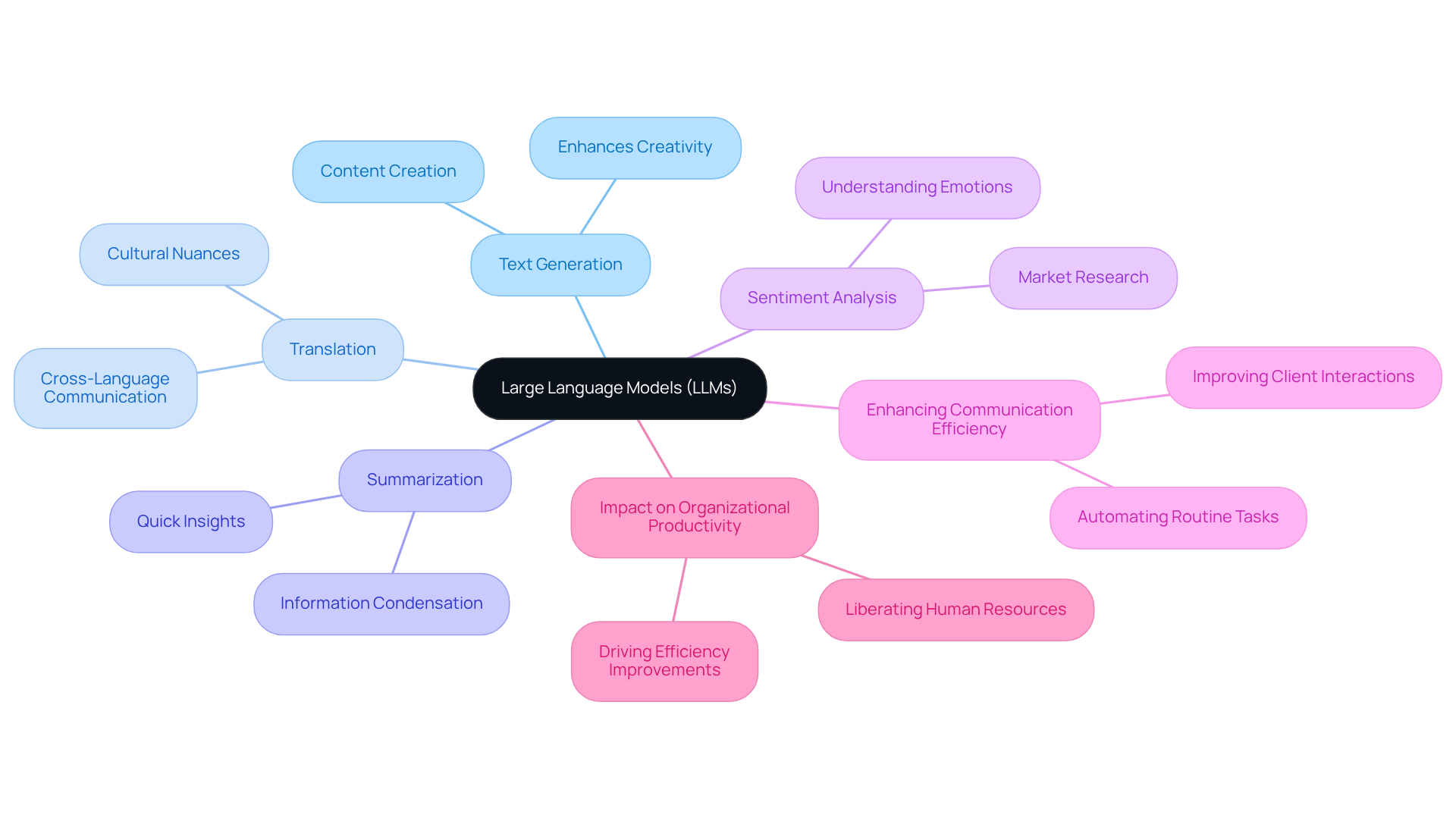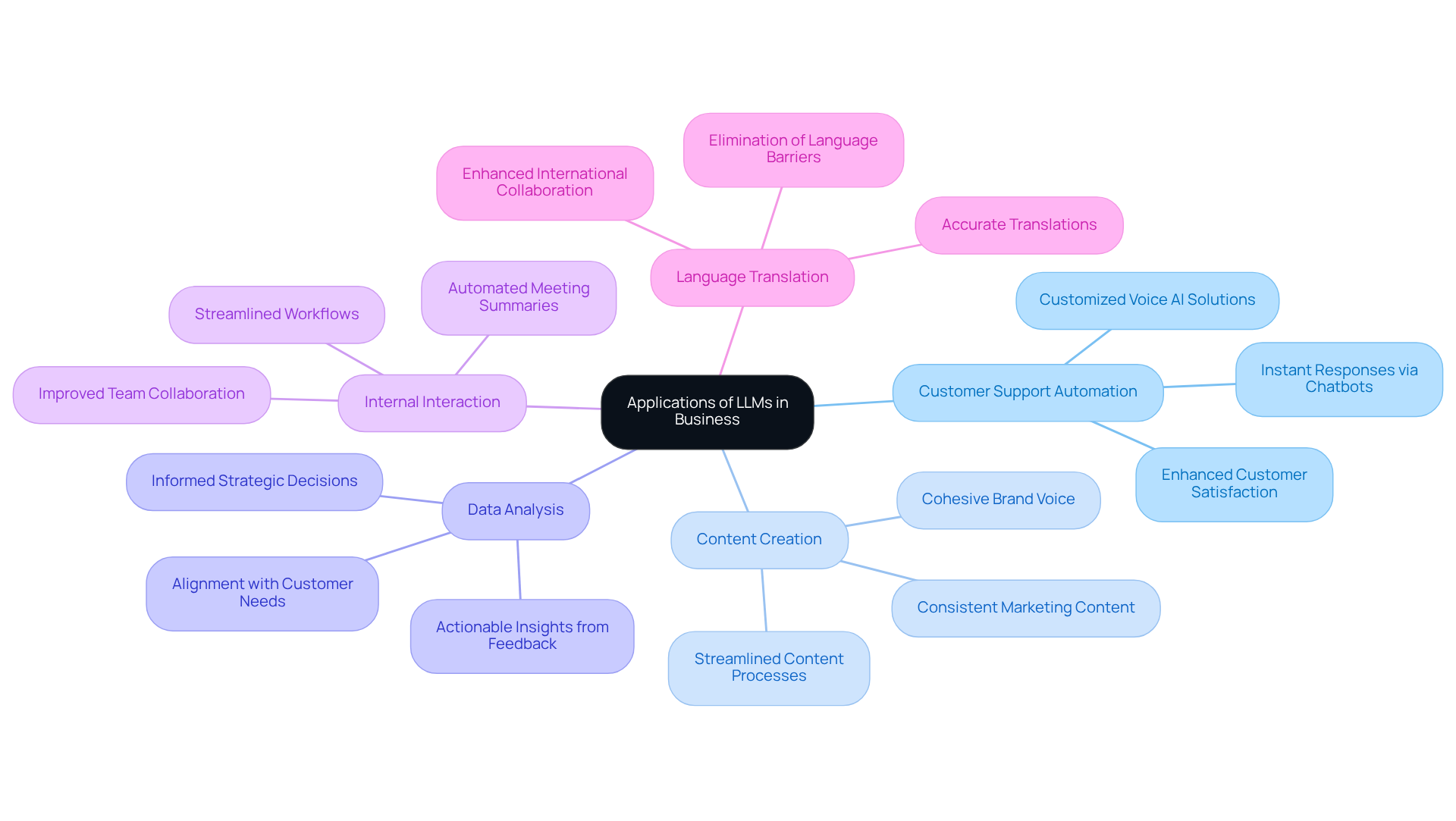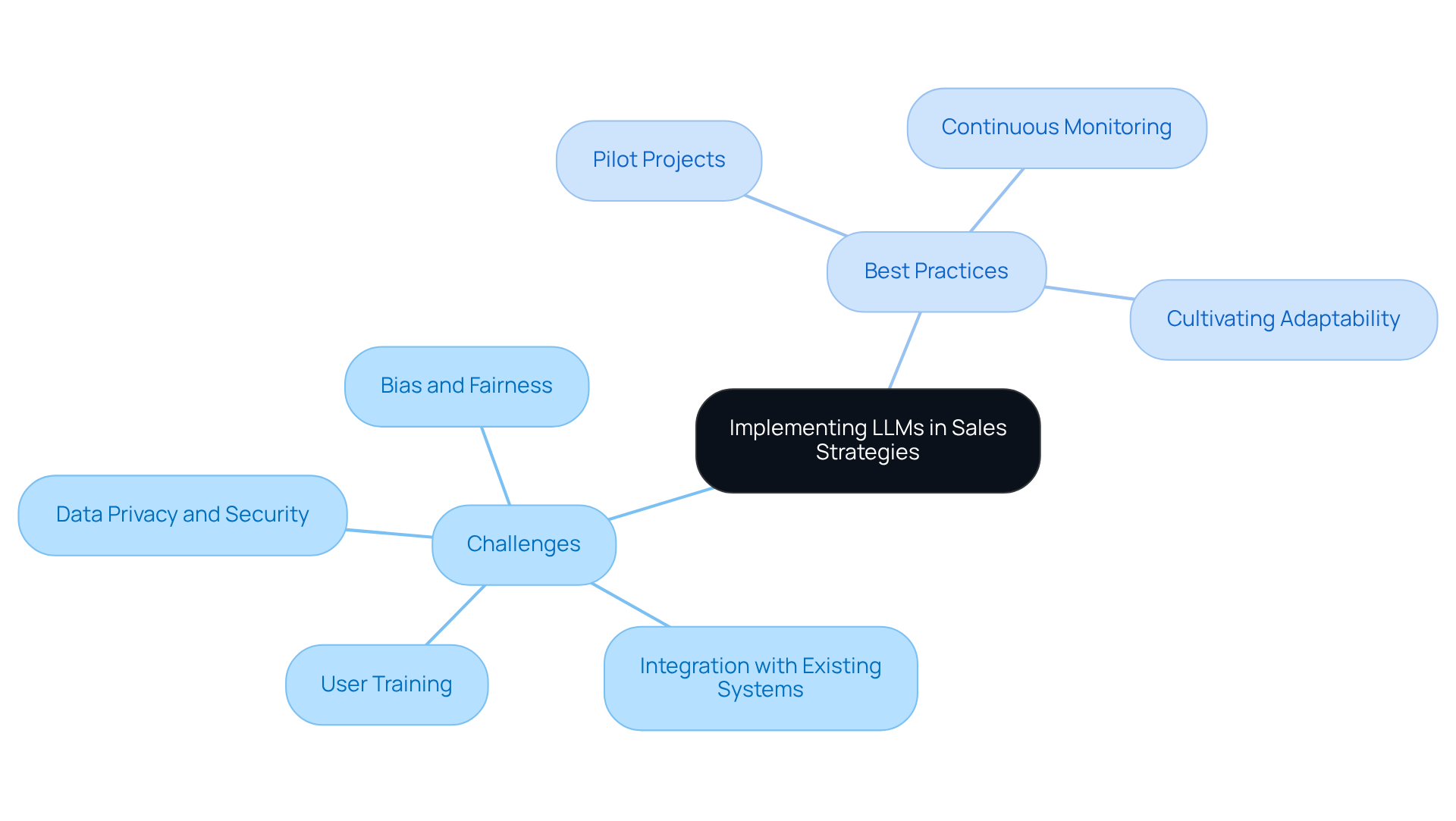
Understanding AI LLM Meaning for Enhanced Business Communication
GeneralOverview
This article delves into the transformative significance of Large Language Models (LLMs) in enhancing business communication. By examining applications such as:
- Customer support automation
- Content creation
- Internal interactions
it highlights how LLMs are revolutionising the way organisations operate. LLMs not only improve efficiency but also effectiveness within organisations, making them indispensable tools in today’s business landscape. However, it is crucial to address challenges such as:
- Data privacy
- The necessity for user training
to ensure successful implementation. Embracing these advanced AI solutions positions businesses for success in an increasingly competitive environment.
Introduction
Large Language Models (LLMs) stand at the forefront of artificial intelligence, fundamentally transforming how businesses communicate and operate. By grasping the intricacies of LLMs, organisations can unlock a wealth of benefits—ranging from automating customer support to enhancing content creation and data analysis. Yet, as companies adopt these advanced technologies, they must confront challenges such as:
- Data privacy
- Integration complexities
- Potential biases
How can businesses effectively harness the power of LLMs while overcoming these obstacles?
Define Large Language Models (LLMs) and Their Role in AI
The ai llm meaning is exemplified by Large Language Models (LLMs), which represent a pinnacle of advanced AI systems meticulously engineered to comprehend, generate, and manipulate human language. By harnessing deep learning techniques—especially transformer architectures—these models adeptly process vast quantities of text data. The AI LLM meaning encompasses how LLMs excel in a multitude of tasks, including:
- Text generation
- Translation
- Summarization
- Sentiment analysis
Their remarkable ability to learn from diverse datasets exemplifies the ai llm meaning, empowering them to produce coherent and contextually relevant responses, making them indispensable for enhancing communication efficiency within organisations.
Agentics leverages the power of LLMs to develop tailored voice AI solutions that automate routine language tasks. This strategic automation liberates human resources, allowing teams to focus on more impactful activities. The integration of LLMs not only amplifies overall productivity but also enriches client interactions. This highlights the transformative potential of LLMs, which relates to the ai llm meaning, in streamlining organisational operations and driving significant improvements in efficiency and effectiveness.

Explore Applications of LLMs in Business Communication and Automation
Large language models (LLMs) are revolutionising business communication and automation through a variety of impactful applications, including:
- Customer Support Automation: LLMs significantly enhance customer satisfaction by powering chatbots and virtual assistants that provide instant responses to inquiries, drastically reducing response times. Agentics leverages large language models to develop customised voice AI solutions, ensuring clients receive timely and precise support.
- Content Creation: Organisations utilise large language models to generate consistent marketing content, reports, and social media posts, streamlining the content creation process and conserving valuable time. Agentics’ solutions empower companies to maintain a cohesive brand voice across all platforms, thereby enhancing engagement.
- Data Analysis: By analysing client feedback and market trends, LLMs deliver actionable insights that inform strategic business decisions, enabling organisations to adapt swiftly to changing market dynamics. Agentics employs these insights to refine its voice AI offerings, ensuring they align with evolving customer needs.
- Internal Interaction: Automating routine internal communications, such as meeting summaries and updates, streamlines workflows and fosters improved collaboration among teams. Agentics’ voice AI solutions facilitate seamless interaction within organisations, ultimately boosting productivity.
- Language Translation: Large language models eliminate language barriers by providing accurate translations, promoting smooth interactions among international teams and enhancing collaborative efforts. Agentics’ technology supports multilingual functions, simplifying operations for enterprises across diverse markets.
These applications illustrate the ai llm meaning, demonstrating how large language models not only enhance operational efficiency but also empower businesses to harness advanced AI technologies for superior communication and client engagement. As organisations navigate the complexities of AI adoption, it is essential to address concerns regarding job security, ensuring that employees feel supported in this evolving landscape.

Identify Challenges and Best Practices for Implementing LLMs in Sales Strategies
Implementing large language models (LLMs) in sales strategies presents distinct challenges that must be addressed:
- Data Privacy and Security: Safeguarding customer data is of utmost importance. Businesses are required to comply with regulations such as GDPR when utilising models that are classified under ai llm meaning.
- Integration with Existing Systems: The ai llm meaning refers to the complexity and resource-intensive nature of incorporating large language models into current workflows and systems.
- Bias and Fairness: In the context of ai llm meaning, there is a risk that large language models may inadvertently perpetuate biases present in their training data. Regular auditing and refinement of models are essential to ensure fairness in outputs, which relates to the ai llm meaning.
- User Training: It is critical for sales teams to receive training on effectively utilising large language models, which includes understanding ai llm meaning, as well as their capabilities and limitations.
Best Practises:
- Initiate pilot projects to explore LLM applications prior to full-scale implementation.
- Maintain continuous monitoring and evaluation of LLM performance to ensure alignment with business objectives as per the ai llm meaning.
- Cultivate a culture of adaptability within the sales team to embrace AI-driven transformations in communication and processes.

Conclusion
Large Language Models (LLMs) stand as a transformative force in the realm of business communication, empowering organisations to significantly enhance efficiency and effectiveness through advanced AI capabilities. By grasping the meaning of AI LLMs, businesses can effectively leverage these models to automate routine tasks, streamline processes, and foster improved interactions both internally and with clients.
The article highlights several key applications of LLMs, including:
- Customer support automation
- Content creation
- Data analysis
- Internal communication
- Language translation
Each application not only showcases the versatility of LLMs but also underscores their potential to revolutionise organisational operations. However, the implementation of LLMs does present challenges such as:
- Data privacy
- Integration complexities
- The necessity for user training
These challenges must be navigated thoughtfully to maximise the benefits.
As businesses advance in integrating LLMs into their communication strategies, it is crucial to embrace best practises, such as:
- Initiating pilot projects
- Fostering a culture of adaptability
By doing so, organisations can effectively harness the power of AI to enhance communication and drive significant improvements in overall productivity and client engagement. Embracing this technology positions businesses at the forefront of innovation and ensures they remain competitive in an increasingly AI-driven landscape.
Frequently Asked Questions
What are Large Language Models (LLMs)?
Large Language Models (LLMs) are advanced AI systems designed to understand, generate, and manipulate human language using deep learning techniques, particularly transformer architectures.
What tasks can LLMs perform?
LLMs excel in various tasks including text generation, translation, summarization, and sentiment analysis.
How do LLMs learn and produce responses?
LLMs learn from diverse datasets, enabling them to generate coherent and contextually relevant responses, which enhances communication efficiency.
How do organisations benefit from using LLMs?
Organisations benefit from LLMs by automating routine language tasks, which allows human resources to focus on more impactful activities, thereby increasing overall productivity and improving client interactions.
What is the significance of LLMs in enhancing organisational operations?
The integration of LLMs streamlines operations and drives significant improvements in efficiency and effectiveness within organisations.
Enjoyed this post? Share it with your network!
10 Best AI Sales Tools to Boost Your Team’s Performance

Discover the top 10 best AI sales tools to enhance team performance and drive revenue growth.
Mastering Test Call Numbers: A Step-by-Step Guide for Sales Directors

Elevate your communication with our guide on mastering test call numbers for sales success.
7 Ways Automated Outbound Calls Boost Sales Performance

Discover how automated outbound calls enhance sales performance and streamline communication.
